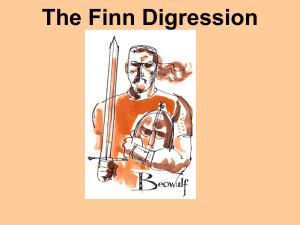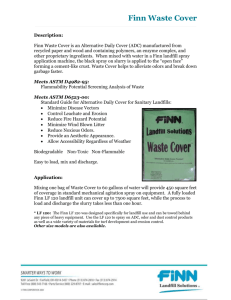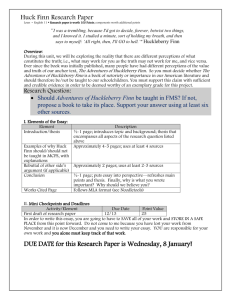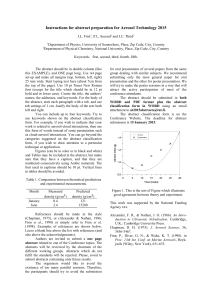M030271-00
advertisement
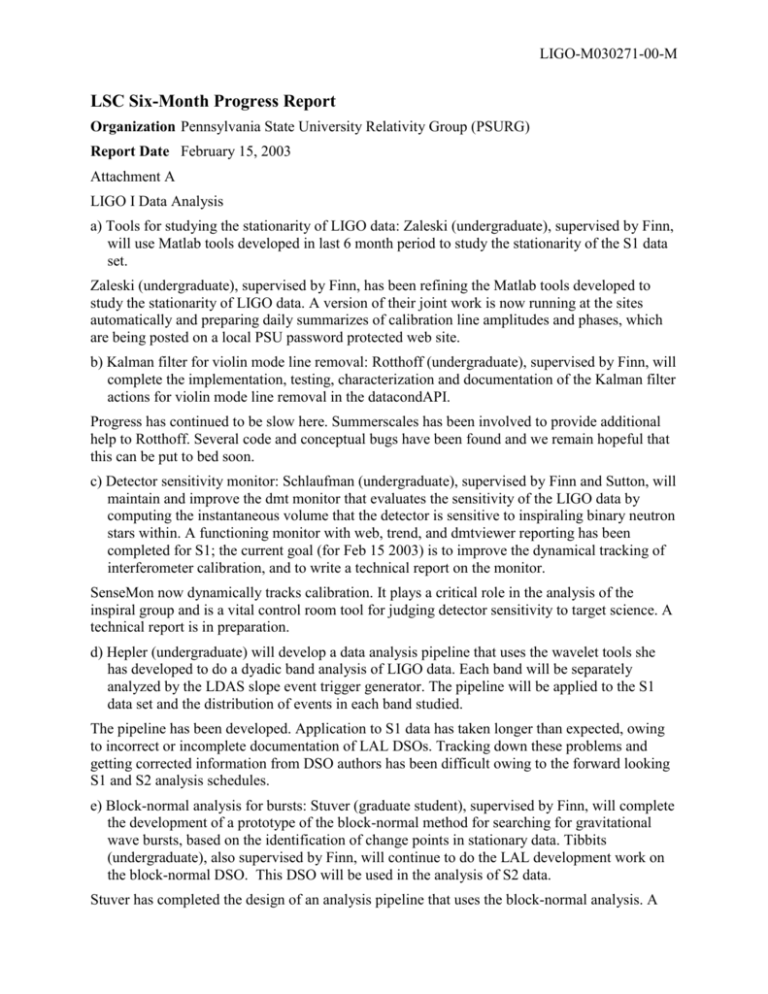
LIGO-M030271-00-M LSC Six-Month Progress Report Organization Pennsylvania State University Relativity Group (PSURG) Report Date February 15, 2003 Attachment A LIGO I Data Analysis a) Tools for studying the stationarity of LIGO data: Zaleski (undergraduate), supervised by Finn, will use Matlab tools developed in last 6 month period to study the stationarity of the S1 data set. Zaleski (undergraduate), supervised by Finn, has been refining the Matlab tools developed to study the stationarity of LIGO data. A version of their joint work is now running at the sites automatically and preparing daily summarizes of calibration line amplitudes and phases, which are being posted on a local PSU password protected web site. b) Kalman filter for violin mode line removal: Rotthoff (undergraduate), supervised by Finn, will complete the implementation, testing, characterization and documentation of the Kalman filter actions for violin mode line removal in the datacondAPI. Progress has continued to be slow here. Summerscales has been involved to provide additional help to Rotthoff. Several code and conceptual bugs have been found and we remain hopeful that this can be put to bed soon. c) Detector sensitivity monitor: Schlaufman (undergraduate), supervised by Finn and Sutton, will maintain and improve the dmt monitor that evaluates the sensitivity of the LIGO data by computing the instantaneous volume that the detector is sensitive to inspiraling binary neutron stars within. A functioning monitor with web, trend, and dmtviewer reporting has been completed for S1; the current goal (for Feb 15 2003) is to improve the dynamical tracking of interferometer calibration, and to write a technical report on the monitor. SenseMon now dynamically tracks calibration. It plays a critical role in the analysis of the inspiral group and is a vital control room tool for judging detector sensitivity to target science. A technical report is in preparation. d) Hepler (undergraduate) will develop a data analysis pipeline that uses the wavelet tools she has developed to do a dyadic band analysis of LIGO data. Each band will be separately analyzed by the LDAS slope event trigger generator. The pipeline will be applied to the S1 data set and the distribution of events in each band studied. The pipeline has been developed. Application to S1 data has taken longer than expected, owing to incorrect or incomplete documentation of LAL DSOs. Tracking down these problems and getting corrected information from DSO authors has been difficult owing to the forward looking S1 and S2 analysis schedules. e) Block-normal analysis for bursts: Stuver (graduate student), supervised by Finn, will complete the development of a prototype of the block-normal method for searching for gravitational wave bursts, based on the identification of change points in stationary data. Tibbits (undergraduate), also supervised by Finn, will continue to do the LAL development work on the block-normal DSO. This DSO will be used in the analysis of S2 data. Stuver has completed the design of an analysis pipeline that uses the block-normal analysis. A LIGO-M030271-00-M preliminary version of the pipeline has been implemented by Tibbits and is being run on S2 data to gain familiarity with the performance of the statistic on real data, and a more complete version of the analysis is underway. A technical report on the pipeline and the block-normal statistic are underway f) Identifying high-order moment correlations: Summerscales (graduate student), will apply the Matlab test code for high-order correlations to the S1 data set. The Matlab test code will be packaged as a Matlab tool box and made generally available to the collaboration, together with a technical report describing its use. A short report describing the test and its uses will also be prepared for submission to Astroparticle Journal. Summerscales has completed the development of the high-order correlations test and its implementation as a Matlab toolbox, which is generally available to the collaboration at http://gravity.psu.edu/~tzs/toolbox. The test has been applied to S1 data, finding significant evidence of non-linearities during epochs when violin modes are active. While the violin mode power can be removed via Kalman filtering, the non-linear coupling remains. These results are summarized in a web notebook, accessible to members of the LIGO I collaboration. A technical report describing the analysis, the toolbox, and the results of this analysis on S1 data are underway. g) Continuous wave search code: Berukoff (graduate student) will continue debugging and maintaining the demodulation code in the LAL pulsar package as needed by the Pulsar Upper Limits group. Berukoff (graduate student supervised by Owen) continued debugging and optimizing the demodulation code in the LAL pulsar package as needed by the Pulsar Upper Limits group. h) Ramsunder (graduate student), supervised by Finn, will perform benchmarks on the performance of LDAS for data analysis on several different computer configurations. A matrix of configuration possibilities involving the interconnect and the compute nodes controlled by the wrapperAPI will be studied. On the network axis we are interested in three possibilities: fast ethernet, gigabit and dophin gigabit (assuming that dolphin operates behind system calls and does not require any modifications to the ldas build). On the compute node axis we are interested in single processor nodes vs. dual processor nodes. The information we want to collect is time to complete the analysis of the data set we have identified for testing purposes. The analysis will be on a representative job mix drawn from our (LIGO's) most recent analysis effort. The final product is a technical report describing the throughput (which we define here to be the reciprocal of the time to complete analysis) per cpu (*not* node). This work will form the basis for a set of recommendations to the LSC for the configuration of the PSU LSC tier 2 center. Ramsunder has completed filling the matrix for the interconnect and for the burst and stochastic searches. The matrix entries for the inspiral search are underway. The clear evidence is that there is no significant downside to using multi-processor nodes in the LDAS Beowulf. Combined with their significantly lower cost per CPU, the Penn State group will propose to build its center around dual processor Beowulf nodes, devoting programming resources as needed to assist the LDAS team with supporting the mpiAPI for use with multi-processor nodes. The results of the interconnect investigations show that there is no gain in going to proprietary gigabit network fabrics. i) `Rayleigh' Monitor: Sutton (Postdoc) has completed a GUI interface to the Rayleigh monitor LIGO-M030271-00-M and demonstrated its use at LHO. His immediate goal (for Feb 15 2003) is to write a technical report describing the monitor, its functioning, the interpretation of its output, and examples of its use for the LIGO DCC. No progress has been made toward this goal. j) LIGO/SWIFT Collaboration: Finn (faculty) will represent LIGO on the SWIFT Science Team. Working with Krishnan and Sutton (postdocs), he has developed a figure of merit that characterizes the sensitivity of the LIGO/SWIFT instrument pair to gravitational waves from gamma-ray bursts for different Swift pointings relative to LIGO's orientation. The immediate goal (for Feb 15 2003) is to complete a manuscript describing the figure of merit and develop a module that the SWIFT team can use in the optimization process for determining satellite pointing. The results of this work were presented at the ’02 GWDAW. The manuscript describing the work is under review by Penn State Swift team members and should be submitted shortly. k) Matched filtering search for precessing binaries: Owen (faculty) will estimate the computational costs of matched filtering searches for the inspirals of precessing compact binaries, using two families of approximate waveforms in the existing literature (Apostolatos 1996, Grandclement and Kalogera 200). This work is done in collaboration with Alberto Vecchio at the University of Birmingham in England (covered under the GEO600 MoU). The goal is to submit, before the March 2003 LSC meeting, a paper that computes the parameterspace metrics of both sets of waveforms, estimates costs of searches of various regions of parameter pace, and proposes regions of low cost and high reward to be targeted by LIGO I. Owen (faculty) coded a parameter-space metric for a simple set of precessing waveforms (Apostolatos 1996) and drafted part of a manuscript on a search for such waveforms in collaboration with Alberto Vecchio (at the University of Birmingham, England, covered by the GEO600 MOU). l) Matched filtering search for binary black holes: Owen (faculty) will code into LAL a set of waveform generators for the various approximations to the end of inspiral, appropriate for binary black holes in the LIGO-I band, catalogued in the literature (Buonanno, Chen, and Vallisneri 2002). These will form the basis of future searches for binary black holes by the Inspiral Upper Limits group, which is currently focused on neutron star binaries. Owen (faculty) performed validation checks on waveform generators in the LAL inspiral package intended to reproduce waveforms in the literature (Buonanno, Chen, and Vallisneri 2003), comparing with data files generated by Michele Vallisneri. m) Administration a. Finn has continued to serve on the LSC executive committee. b. Finn has continued to serve as the GWIC executive secretary c. Finn has continued to serve as co-Chair of the unmodeled source analysis group. d. Finn has continued to represent the PSU tier 2 center on the LSC Comp Coord Comm. e. Finn has continued to supervise the development of the PSU tier 2 center. During this reporting period the PSU tier 2 center started two new support personnel, postdoc John McNabb and systems programmer Michael Foster, bring the staff to full-strength. LIGO-M030271-00-M f. Finn has continued to serve on the LIGO Software Coordination Committee (this committee has not met in the most recent reporting period but has not been dissolved). g. Finn has continued to supervise and participate in the work described in this Attachment associated with Summerscales, Stuver, Sutton, Hepler, Rotthoff, Tibbits, and Schlaufman.


